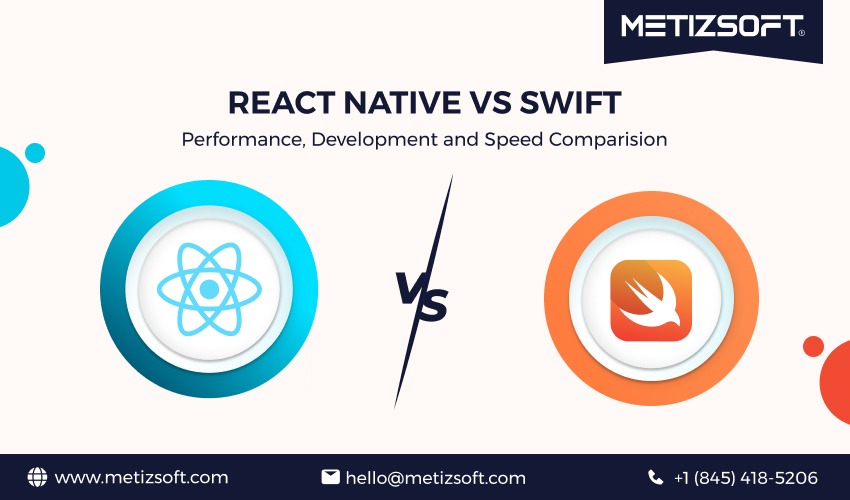
The mobile app industry is overgrowing with each technological advancement. Android or iOS, every OS is experiencing a broad-spectrum upliftment in the user base due to this advancement.
As a result, many mobile app development languages and frameworks have emerged to fulfill mobile app development in the last decade.
However, few have, such as React Native vs. Swift made it to the top list of highly used mobile app development frameworks amongst the enterprises and developers’ community.
The high-end use of these two mobile app development frameworks has surpassed all expectations. It has started the expert community discussion on the best and most suitable for robust iOS app development.
The discussion seems evident as tech giants worldwide have adopted both these frameworks over many top platforms’ development. To end the dilemma, here’s a comprehensive comparison between React Native Vs. Swift.
Table of Contents
What is React Native?
React native is a broadly used JavaScript framework that gained massive popularity and userbase. Since its release by Facebook (Meta) in 2014, it has been the first pick for developers to build dynamic, cross-platform mobile applications.
The exponential components like the reusable codebase, extended community support, and easy-to-learn libraries and configuration have made React Native a cost-effective mobile app development framework over many.
Some of the renowned React Native platforms with a worldwide user base include the following:
- Walmart
- Bloomberg
- Skype
- Walmart
- Tesla
- Wix
What is Swift?
iOS app developers’ and technology enthusiasts’ eyes light up whenever they hear the name SWIFT. Swift is a new age multi-paradigm programming language designed by Apple to build their iOS-powered applications for Mac, Ipad, and iPhone, Apple Watch.
It was launched in the same year as React Native (2014) to replace Apple’s previously used language Objective-C. Swift is currently distributed on an Apache license, making it readily available for the iOS App developers community to use at their convenience.
Some of the renowned Swift platforms with a worldwide user base include the following:
- Slack
- Uber
- Airbnb
- Truecaller
- Medium
- Khan Academy
Pros and Cons of React Native
Pros
- Reusable Codebase
React Native comes with a single and reusable codebase. It allows developers to reuse the code to work on various projects simultaneously. It reduces their development time, cost, and effort.
- Highspeed, Flawless Performance
Native applications are built for a specific operating system that takes full advantage of the device’s processing speed. Such apps show stability, error-free performance, and smooth operation.
- Easy to Navigate
React Native build user interface is straightforward and allows end-users to quickly and easily learn how to navigate the app.
- Advanced Developers Tool & SDK
React Native Developers have access to many libraries and package solutions that interact with a specific and regularly updated OS. It uses a JavaScript library that allows them to develop top-notch iOS and Android systems.
- Low-cost development
Using a cross-platform framework ensures low-cost development from the beginning. The single codebase takes less time and effort to develop an application, which reduces application development costs.
- High-end Performance
Mashups’ characteristics and internal functions are similar to native apps. It allows developers to speed up the entire development process and maintain a consistent end-user experience.
Cons
The only significant drawback of React Native is that it becomes a liability if you are using it to create large-scale applications.
For small apps and minor changes and migration, it’s the best you can get compared to others. But for heavy applications, the cost, effort, time, and compatibility extended to a larger spectrum.
Pros & Cons of Swift
Now it’s time to dive deep inside the Swift universe to explore its pros and cons for better understanding and knowledge.
Pros
The Apple team has ensured high-end compatibility between Swift programming language and Objective-C, allowing developers to use both for the same project.
This compatibility helps build large and complex projects being renovated or expanded. iOS App developers can add more functionality using Swift by taking advantage of the Objective-C codebase.
Moreover, Swift is a well-versed language for both front-end and back-end applications. Developers can reuse and share the codebase, significantly reducing the development effort and speeding up the development process.
Due to the increased demand for apple products, Swift has gained massive popularity and is widely used to build impactful and futuristic Apple applications. The Swift community has been expanding rapidly in the last couple of years.
Cons
The only significant drawback of Swift mobile development is that sometimes the product loses track, leading to poor quality user experience.
However, similar to React Native, Swift is still too young, and there’s often a lack of talent to implement the whole tech stack on Swift.
React Native Vs. Swift Comparison
Let’s closely examine some key prospects of React Native and Swift to summarize the comparison.
- Development Speed
If we compare React Native vs. Swift’s development speed, Swift is much faster in developing native iOS Apps. Also, it is the easiest way to create an iOS app compared to other frameworks.
On the other side, React Native is a robust JavaScript framework that offers a simple working tool for building web applications. Its development speed is good but not as good as Swift’s in many ways.
- Performance
Performance-wise, Swift overtakes React Native in most cases. However, Swift consumes more CPU space and power when running an application. Also, it supports a high-end GUI that enhances the UI and offers better performance.
Meanwhile, React Native compatibility with high-quality GUI is not as good as Swift. Alternatively, developers use different codebases, resources, and tools to solve these problems.
- User Interface
Since Swift belongs to the iOS native language community, it fits well with the iOS design and takes complete advantage of all the latest UX elements. However, you must independently polish each coding section and component for better optimization and performance.
On a different note, React Native employs JavaScript as a core back-end power and internal APIs to run native components. It has no problem being presented on different and various screen sizes due to JavaScript web development implications.
- Learning Efficiency
When it comes to learning, React Native is relatively easy to learn due to the attachment of JavaScript, which has been around for many years. JavaScript is a language known and used by most developers worldwide.
Therefore most developers have a firm grip and proficiency in using it on various platforms. Secondarily, Swift is slightly difficult to learn, if not entirely. However, Swift specialists are rare to find compared to React Native.
- Community & Support
In this contrast, React Native is the clear winner. It has massive support, and two main reasons exist behind such background. The first is Facebook (Meta), and the second is JavaScript.
Swift does have an intense community sport but is not close to React Native. Suppose you are working on a project, regardless of size and category.
In that case, you will easily find React Native solutions as there are many tutorials, documentation, and guidance available on Youtube and its official website.
React Native Vs. Swift – Which option is best for iOS App development?
So far, we have briefed you about the primary and key prospects of React Native and Swift in an easy and precise way to help you determine which one is better and which is not. Now it’s up to you, your budget, and project requirements to decide which fits your budget and needs best.
However, if you want our opinion, which seems inevitable now, you should opt for Swift if only you aim to develop an iOS application. Otherwise, go with React Native without a second thought.
You can develop Android and iOS simultaneously with lower cost, effort, and time. Also, you will gather the developers’ team and resources in no time due to the majority of access to this framework.
All in all, both React Native and Swift have helped developers build exponential apps that are currently ruling their respective domains. You must choose one that best fulfills your project’s requirements rather than the hype and market trend.
Closing Words
So, here’s the final part of the battle between React Vs. Swift. We hope this blog has all the elements you sought in React Native Vs. Swift battle. For better guidance and assistance, you can enrich a renowned mobile app development company and consider their suggestion for better project optimization. Moreover, you can hire React Native developers at your convenience and budget according to your time zone.
AboutChetan Sheladiya
Related Posts
React Native is the Future of Mobile App Development at Shopify
After many successful years of native mobile development, Shopify recently decided and made it official that they’ve decided...
6 Best Cross-Platform Frameworks to Develop Android and iOS App
Cross-platform app frameworks are one of the best things in app development. Instead of just one platform, a developer can now...

